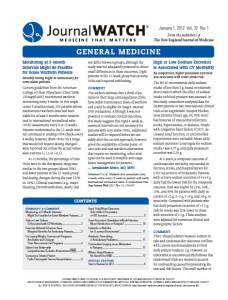February 16th, 2012
What’s New in Medicine
Heidi Zook, MD
Staying up to date with the most recent advances in medicine is a challenge and a necessity if we want to offer patients the best care possible. That being said, being a physician is one of the busiest careers and finding free time to read journals is not exactly easy. That’s where Journal Watch comes into play — it makes this difficult task easier. Following in the footsteps of our predecessor, Dr. Greg Bratton, I’d like to share some recent Journal Watch content that has had an impact on me and potentially the way I practice medicine. Two of the articles are from the Journal Watch General Medicine Year in Review 2011 — a review of the year’s most important thematic areas in clinical research.
To Dr. Bratton — if you are reading, imitation is the sincerest form of flattery!
To our blog readers —which articles had an impact on you? I’d like to know.
For Losing Weight, Commercial Programs Are Better and Cheaper Than Noncommercial Programs — Obesity is an epidemic in our country, and likely one of, if not the, largest consumer of healthcare dollars, yet we have so few tools to help prevent and control this disease. Many of the pharmacologic treatments that have existed in the past have been pulled off of the market. The idea that we could “prescribe” a commercial program might get more of a response than simply counseling on diet and exercise. Joining a commercial program could offer our patients the support, follow-up, and lifestyle coaching that a 20-minute office visit could never offer. That being said, this idea should not deter a physician from continuing to counsel their patients on how to maintain a healthy weight and stay healthy. This is a battle that we will all fight during our careers, just like heart disease and diabetes. The more tools we have, the better.
USPSTF Recommends Against Prostate Cancer Screening — Considering the controversy that developed in 2011 on the subject, I couldn’t resist discussing it as something that impacted my practice. During my interpretation of all of the recommendations that currently exist, I spoke with some of my mentors and more experienced colleagues on the subject. This is undoubtedly a controversial issue. On the one hand, many have experienced diagnosing prostate cancer in a younger man through screening, buying some lucky individuals a significant amount of quality life that they may not have otherwise had. On the other hand, many have seen individuals going through invasive diagnostic and therapeutic measures, with resulting morbidity from the procedures that may not have been necessary in the first place. Add in the potential cost of screening “…the cost to prevent one prostate cancer death through screening would be roughly US$5.2 million” and you end up with a difficult decision. At this point, I discuss the options, risk, and benefits with patients who would be appropriate for prostate screening. I believe that a strong family history as well as any symptoms that might suggest possible prostate cancer in a patient makes the argument on whether or not to screen quite a bit easier.
Atypical Femur Fractures with Bisphosphonates — This was another topic that led to difficult and, for the patient, confusing conversations. It is difficult to convince a patient to take a medication that may cause what it is, in theory, supposed to prevent. I have had discussions with all of my patients who have been on bisphosphonates longer than five years about these recent findings, but I think the following says it all: “Among women with FDA-approved, evidence-based indications for bisphosphonate therapy (i.e., documented osteoporosis or previous osteoporotic fracture), the number of typical hip fractures prevented by bisphosphonate therapy would outnumber the number of atypical femur fractures caused by treatment.” Well said, well said.

